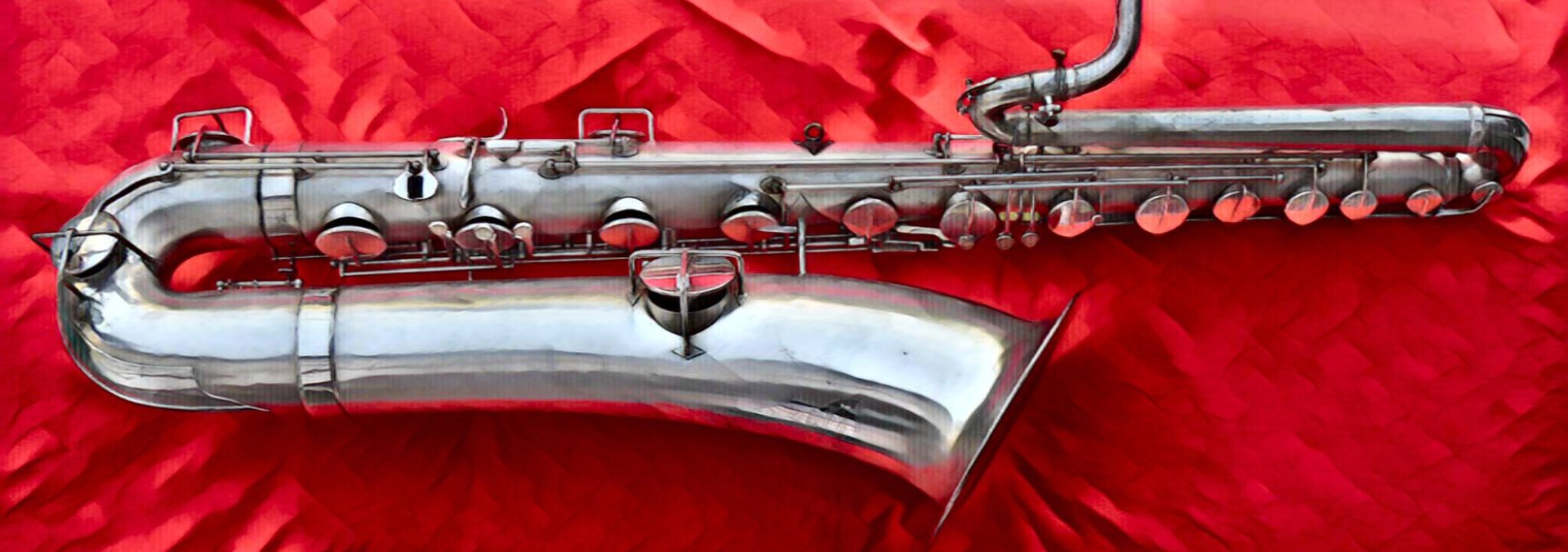
I was in my tech’s shop the other day, and had the chance to unpack a very special horn that was sent to him for repair: a Max Keilwerth-made Globermaster Luxus alto serial, # 56XX. This horn arrived all the way from New York State because the owner was willing to try one more tech before giving up on this horn altogether.
You see, the owner had bought the horn through eBay; had it overhauled; but could not get it to play in tune. According to the owner:
The problem is that the instrument is wildly out of tune. Horribly out of tune. The entire left hand stack is very flat, and the open key position is the worst offender.
Multiple techs in and around New York had tried various things ranging from a tuning crescent on the low C tone hole, to a brass band inside the neck tenon. All to no avail unfortunately. This MK horn just would not play in tune for its owner.
The way the owner found out about my tech was through me. The owner, let’s call him Bob, reached out to me a few months ago and asked if I had ever heard of these kinds of problems with MK-made horns before.
I had to admit to Bob that as much as I had written and researched Max Keilwerth horns, I had played none older than Hohner Presidents. Therefore I reached out to my tech, who off the top of his head rattled off a list of 5 or 6 things that could be wrong with the Globemaster Luxus, based on where the tuning problems were.
I forwarded this information onto Bob, and also passed on David’s contact information. I then left it up to the two of them to talk amongst themselves.
Timing really is everything….
Fast forward a couple of months, and sure enough Bob’s much-loved, but out of tune, Globemaster Luxus alto appeared at David’s shop.
Last week I took a couple of my baris in to be worked on, and while David was doing the work, I carefully unpacked the Globemaster Luxus. I had brought an alto MP along to try it out, and also my camera to take some photos.
The horn was fantastically packed, and survived the trip with no ill effects. Despite not having had its keys corked down, its alignment was not adversely affected by the trip. I subtoned down to low Bb with no difficulties whatsoever.
The horn played up to high F with no problems either. However, where it did run into some problems was with its intonation around the A2 and higher. I could get the horn to play perfectly in tune, but it required extreme facial calisthenics on my part. I cannot recall ever having to contort my face so much to get a horn to play in tune.
That said, if I could get it to play in tune with embouchure adjustments, my thinking was that this horn is perfectly capable of playing in tune.
The wear on the horn’s silver plate would seem to bear this out, since it was clearly played a lot. Yet this horn is in extremely good mechanical shape, and it shows no signs of past damage or mistreatment. The only sign of past solders is the chromatic F# key guard.
What’s this strange floating lever on this Globemaster Luxus all about, and do other MK horns have it?
What I noticed on this Globemaster Luxus, that neither David nor I had ever seen on another saxophone before, were 2 floating levers to operate the upper octave key. The first was conventional, and was operated by the octave lever. The second however, was operated by the high F key.
At first I thought it might be a way to ensure the upper octave key opens no matter what position you have the neck angled at. (My Martin Handcraft is notorious for being very picky. If you don’t have the neck positioned just right, the upper octave key will fail to open.)
However, as it turns out, that wasn’t it at all….
Upon closer inspection I noted that the high F key has 2 stages of operation—just like the high Eb key on my bass does, thanks to Paul Coats who rebuilt it with the assistance of Steve Goodson. In the first stage the high F key operates just like a normal high F keys does. But depress it further, and then it opens a bit more and lifts the octave key on the neck higher than it normally is open with the octave key alone.
Since this was such an unusual feature, I decided to reach out to the one person I know personally, who I know has seen thousands of vintage saxophones in his career, and now designs his own line of saxophones. Steve Goodson knows a great deal about saxophone acoustics, so I turned to his expertise to see what his insights might be.
Steve’s thoughts on this Globemaster Luxus’ unusual feature were:
I have never seen this before BUT it does make a certain amount of acoustic sense. Most technicians incorrectly set the front F key so that it opens the F palm key as much as possible. I’ll spare you the lengthy explanation, but the front F and E speak and have better pitch if the front F key opens the F pad about 1/4 of an inch and no more. Unfortunately, this lack of venting can have an adverse effect on altissimo fingerings involving the front F key. I suspect that this is where MK was going with this. I would have to experiment to be sure.
Because by the time I noticed this feature I had my MP and stuff away, I didn’t have a chance to try it out. Therefore once David has found out if it changes the pitch of the high F at all, he’ll let me know.
In looking through my Max Keilwerth galleries to see if other horns he built had this feature, I was stymied by photos provided by the sellers of the instruments. Many of these pics were of such poor quality, that even when this area of the horn was photographed, the details were incredibly difficult to make out.
In the end however, I could most definitely see the feature on only one other Max Keilwerth horn: Globemaster Luxus, #5080. I find it interesting that it appears on no tenors, and not any of MK’s own Mars or President horns—even those of similar serial #s. I wonder what that’s about???
If I had to come up with a theory on the Globemaster & Globemaster Luxus….
Given the extra engraving below this particular Globemaster Luxus’ model name, K.Fulik Jenišovice—there is no extra engraving on #5080 that I linked to above BTW—I am beginning to wonder if Globemaster wasn’t also an MK model, since neither the Mars nor the President seems to have come in full pearl versions. Perhaps the Globemaster Luxus was Max Keilwerth’s top of the line model, since the conventional Globemaster did not have the extra floating lever, nor the full mother of pearl key touches.
Since most of MK’s original history no longer exists, it is unlikely that these questions will every be answered, or that the mystery surrounding the extra floating lever will ever categorically be solved.
In the meantime, if you own a Max Keilwerth-made horn with double floating levers, PLEASE get a hold of me. Leave me a comment, or send me an email. I am doing my best to research this Keilwerth brother’s horns, and I’m coming to realize that the more I know, the less I ever knew. Every little bit of information helps. Thank you!






























I did a small experiment with a Hohner alto regarding the two positions of the F palm key cup and the octave pip.
First I tuned the saxophone on the upper C sharp. With the same embouchure the palm key F was reasonably in tune. I removed the F palm key, closed the hole with my right hand, checked the tuning of C sharp and opend, with the same embouchure, all tone holes above C sharp. Without F palm key the pitch was approximately F sharp. Fidgetting with the upper octave pad also changed the pitch.
So it is possible that this mechanism can be used as an alternative F sharp mechanism.
I have an Adolf rolz jazz artist very similar but I don’t no nothing about them…. Looks same as this saxophone but no pure tone stamp?
If you would send me some photos, I’ll see what I can find out about it. bassic.sax.info@gmail.com
Hi Helen, did you ever fins out information about the jazz artist? Im also currently looking at one and can’t seem to find any information online about it..
Adolf Rölz was a smaller sax-maker in Graslitz (Kraslice) prior to the 2. world-war. He made nice horns, similar to V. Kohlert’s Söhne and Max Keilwerth. But as well similar to Franz Köhler from Markneukirchen. All those are really good horns and I would clearly recommend them!